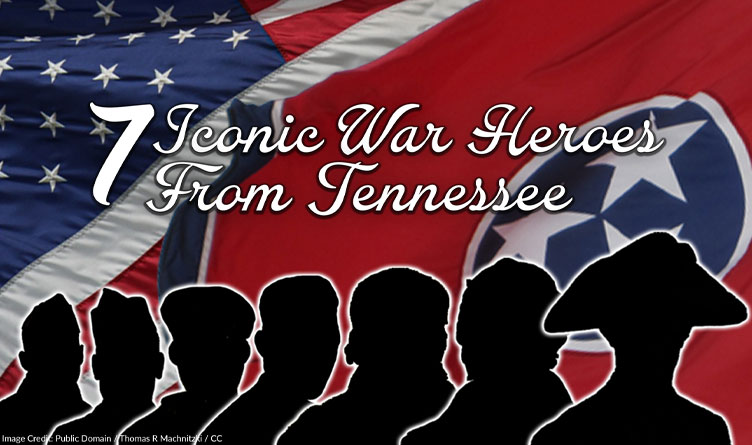Image Credit: compiled from the Public Domain & Thomas R Machnitzki / CC
The Tennessee Conservative [By Jason Vaughn] –
With great respect and appreciation as we approach Memorial Day, we have compiled this list of seven great heroes that called Tennessee their home.
Most names you will quickly recognize, but there are a few that haven’t received the public recognition that they much deserve.
As there are countless heroes from the Volunteer State, we had to limit the number to highlight in this piece to seven. For the many that are left off of our list, they too, all have our utmost respect and heartfelt appreciation for all they did to keep our Nation free.
#1) John Sevier – Tennessee’s First Governor – Revolutionary War

John Sevier was a soldier, frontiersman, and politician, and one of the founding fathers of Tennessee who was born in Augusta County in the Colony of Virginia on September 23, 1745.
He played a leading role in Tennessee’s pre-statehood period, both militarily and politically, and he was elected as the state’s first governor in 1796. He served as a colonel of the Washington District Regiment in the Battle of Kings Mountain in 1780, and he commanded the frontier militia in dozens of battles in the 1780s and 1790s.
In 1796, the Southwest Territory was admitted to the Union as the State of Tennessee. Sevier missed the state’s constitutional convention while serving on the territorial council in Washington, but he was elected the new state’s first governor.
Sevier served six two-year terms as Tennessee’s governor: from 1796 until 1801, and from 1803 to 1809. Term limits prevented a fourth consecutive term in both instances.
After his last term as governor, Sevier was elected to three terms in the United States House of Representatives from Tennessee, serving from 1811 until his death in 1815.
#2) Andrew Jackson – First President from Tennessee – Revolutionary War

Andrew Jackson, born on March 15, 1767 in the Waxhaw Settlement between North and South Carolina, British America, was an American lawyer, general, and statesman who served as the 7th president of the United States from 1829 to 1837.
Before being elected to the presidency, Jackson gained fame as a general in the United States Army and served in both houses of the U.S. Congress. An expansionist president, Jackson sought to advance the rights of the “common man” against a “corrupt aristocracy” and to preserve the Union.
Battle of New Orleans – After arriving in New Orleans on December 1, 1814, Jackson formed military units consisting of African-Americans, Muscogees, and French smugglers in addition to recruiting volunteers in the city. Jackson received some criticism for paying white and non-white volunteers the same salary. These forces, along with the U.S. Army regulars and volunteers from surrounding states joined with Jackson’s force in defending New Orleans.
The approaching British force consisted of over 10,000 soldiers, many of whom had served in the Napoleonic Wars. Jackson had only about 5,000 men, most of whom were inexperienced and poorly trained.
The British arrived on the east bank of the Mississippi River on the morning of December 23. That evening, Jackson attacked the British and temporarily drove them back.
On January 8, 1815, the British launched a major frontal assault against Jackson’s defenses. An initial artillery barrage by the British did little damage to the well-constructed American defenses.
Once the morning fog had cleared, the British launched a frontal assault, and their troops made easy targets for the Americans protected by their parapets. Despite managing to temporarily drive back the American right flank, the overall attack ended in disaster.
For the battle, Jackson forces only suffered 71 total casualties. Of these, 13 men were killed, 39 wounded, and 19 missing or captured. The British admitted 2,037 casualties. Of these, 291 men were killed, 1,262 wounded, and 484 missing or captured.
After the battle, the British retreated from the area, and open hostilities ended shortly thereafter when word spread that the Treaty of Ghent had been signed in Europe that December. Coming in the waning days of the war, Jackson’s victory made him a national hero, as the country celebrated the end of what many called the “Second American Revolution” against the British.
By a Congressional resolution on February 27, 1815, Jackson was given the Thanks of Congress and awarded a Congressional Gold Medal.
#3) David (Davy) Crockett – Limestone, Tennessee – Texas Revolution 1836

David Crockett was born on August 17, 1786 in Limestone, Tennessee (at that time, part of North Carolina).
He was a folk hero, frontiersman, soldier and politician.
Crockett grew up in East Tennessee, where he gained a reputation for hunting and storytelling. He was made a colonel in the militia of Lawrence County, Tennessee and was elected to the Tennessee state legislature in 1821.
In 1827, he was elected to the U.S. Congress, was re-elected in 1833, then narrowly lost in 1835, prompting his angry departure to Texas (then the Mexican state of Tejas) shortly thereafter.
In early 1836, he took part in the Texas Revolution and died at the Battle of the Alamo, either in battle or executed after being captured by the Mexican Army.
Crockett became famous during his lifetime for larger-than-life exploits popularized by stage plays and almanacs. After his death, he continued to be credited with acts of mythical proportion. These led in the 20th century to television and film portrayals, and he became one of the best-known American folk heroes.
#4) Alvin C. York – Pall Mall, Tennessee – World War I

Among the most recognized Americans from World War I, Alvin C. York’s name is known worldwide and is emblazoned across the Volunteer State.
He was born on December 13th, 1887 in Fentress County, Tennessee in what is now known as the community of Pall Mall.
Sergeant York was one of the most decorated United States Army soldiers of World War I.
He is credited with single-handedly leading an attack on a German machine gun nest, gathering 35 machine guns, killing at least 25 deeply entrenched enemy soldiers and capturing 132 others. For his brave actions he received the Medal of Honor.
For those who knew him best, York’s claim to fame wasn’t only earned on the field of battle, it was also earned by the establishment of a public high school in the county-seat of Fentress County, Jamestown, which is nearby to his hometown of Pall Mall.
Fentress County, one of the most rural and poor counties in the state, at the time didn’t want a high school. Most wanted their children to get their education by working on the farm.
However, Alvin C. York established York Institute in Jamestown in 1926, which he later turned over to the state in 1937. With barely a third-grade education himself, York was self-taught, and got the school running almost entirely on his own.
He bought the buses, he paid the drivers, he bought the gas and paid the teachers, all with money he raised.
York Institute remains the only state-funded public high school in Fentress County to this day.
#5) Clarence Higgins – Erwin, Tennessee – World War II

Clarence Higgins was born June 17, 1922 in Erwin, Tennessee and joined the U. S. Navy on July 31, 1940.
He was assigned to the light cruiser USS St. Louis as an electrician’s mate and was aboard the ship in Hawaii during the attack on Pearl Harbor on the morning of December 7, 1941.
He had just finished eating his breakfast and was up on the ship’s deck when he noticed several aircraft approaching at an exceptionally low altitude. The aircraft were headed in the direction of “battleship row” when they began dropping torpedoes in the harbor. He immediately ran to the bridge of the ship to inform the officer on duty that they were under attack. Higgins was ordered to go wake up Commanding Officer, Captain G. A. Rood, who opted to forgo changing into uniform and appeared on deck in his pajamas and hat. As Higgins returned to the deck he noticed large red balls on the wings of the enemy aircraft and realized they were the Japanese.
It took the St. Louis about an hour and half to get underway. As they were leaving, Higgins saw a man in the water surrounded by burning oil. As the man was pulled to safety his uniform caught on fire and he was engulfed in flames. Higgins tore off the man’s burning uniform but he still received severe burns.
Higgins also witnessed the bombing of the USS Arizona.
Higgins went on to serve in the Asiatic-Pacific Theatre, serving as an electrician’s mate aboard the submarines USS Sunfish, USS Loggerhead, and USS Skate. He was awarded the WWII Victory Medal, American Area Campaign medal, the Asiatic-Pacific Campaign medal, and the Combat Insignia Award. He was aboard the USS Loggerhead on patrol in the Pacific when the war ended.
#6) William Franklin Lyell – Hickman County, Tennessee – Korean War

William Franklin Lyell was born in Hickman County, Tennessee on February 14, 1929.
U.S. Army Corporal Lyell, as a member of Company F, distinguished himself by conspicuous gallantry and outstanding courage above and beyond the call of duty in action against the enemy.
When his platoon leader was killed, Cpl. Lyell assumed command and led his unit in an assault on strongly fortified enemy positions located on commanding terrain.
When his platoon came under vicious, raking fire which halted the forward movement, Cpl. Lyell seized a 57mm. recoilless rifle and unhesitatingly moved ahead to a suitable firing position from which he delivered deadly accurate fire completely destroying an enemy bunker, killing its occupants.
He then returned to his platoon and was resuming the assault when the unit was again subjected to intense hostile fire from 2 other bunkers. Disregarding his personal safety, armed with grenades he charged forward hurling grenades into 1 of the enemy emplacements, and although painfully wounded in this action, he pressed on destroying the bunker and killing 6 of the foes.
He then continued his attack against a third enemy position, throwing grenades as he ran forward, annihilating 4 enemy soldiers.
He then led his platoon to the north slope of the hill where positions were occupied from which effective fire was delivered against the enemy in support of friendly troops moving up.
Fearlessly exposing himself to enemy fire, he continuously moved about directing and encouraging his men until he was mortally wounded by enemy mortar fire.
An Army Reserve Center is dedicated to him in Nashville, TN.
#7) James Alton Gardner – Dyersburg, Tennessee – Vietnam Conflict

James Alton Gardner was born in Dyersburg, Tennessee on February 7, 1943.
U.S. Army First Lieutenant Gardner won the medal of honor for conspicuous gallantry and intrepidity in action at the risk of his life above and beyond the call of duty.
Gardner’s platoon was advancing to relieve a company of the 1st Battalion that had been pinned down for several hours by a numerically superior enemy force in the village of My Canh, Vietnam. The enemy occupied a series of strongly fortified bunker positions which were mutually supporting and expertly concealed. Approaches to the position were well-covered by an integrated pattern of fire including automatic weapons, machine guns, and mortars.
Even as it moved to begin the attack, the platoon was under heavy enemy fire. During the attack, the enemy fire intensified. Leading the assault and disregarding his own safety, 1st Lt. Gardner charged through a withering hail of fire across an open rice paddy.
On reaching the first bunker he destroyed it with a grenade and without hesitation dashed to the second bunker and eliminated it by tossing a grenade inside. Then, crawling swiftly along the dike of a rice paddy, he reached the third bunker.
Before he could arm a grenade, the enemy gunner leaped forth, firing at him. 1st Lt. Gardner instantly returned the fire and killed the enemy gunner at a distance of six feet.
Following the seizure of the main enemy position, he reorganized the platoon to continue the attack. Advancing to the new assault position, the platoon was pinned down by an enemy machine gun emplaced in a fortified bunker.
1st Lt. Gardner immediately collected several grenades and charged the enemy position, firing his rifle as he advanced to neutralize the defenders. He dropped a grenade into the bunker and vaulted beyond. As the bunker blew up, he came under fire again. Rolling into a ditch to gain cover, he moved toward the new source of fire.
Nearing the position, he leaped from the ditch and advanced with a grenade in one hand and firing his rifle with the other. He was gravely wounded just before he reached the bunker, but with a last valiant effort he staggered forward and destroyed the bunker, and its defenders, with a grenade.
Although he fell dead on the rim of the bunker, his extraordinary actions so inspired the men of his platoon that they resumed the attack and completely routed the enemy.

About the Author: Jason Vaughn, Media Coordinator for The Tennessee Conservative ~ Jason previously worked for a legacy publishing company based in Crossville, TN in a variety of roles through his career. Most recently, he served as Deputy Director for their flagship publication. Prior, he was a freelance journalist writing articles that appeared in the Herald Citizen, the Crossville Chronicle and The Oracle among others. He graduated from Tennessee Technological University with a Bachelor’s in English-Journalism, with minors in Broadcast Journalism and History. Contact Jason at news@TennesseeConservativeNews.com





4 Responses
Jason,
Excellent work, as always.
Thanks.
In Tennessee there’s never been a shortage of heroes to honor. Thanks for this list
Thanks Jason for the great work! There are more heroes from Tennessee than any other state! Just ask the people of Texas who would not be part of this great nation if it was not for heroes that “volunteered” from Tennessee to go fight in the Mexican American War who liberated them.
This has been so wonderful to read. I’ve very much enjoyed this article and have learned some of our rich history. RIP to all our WAR HEROES!!